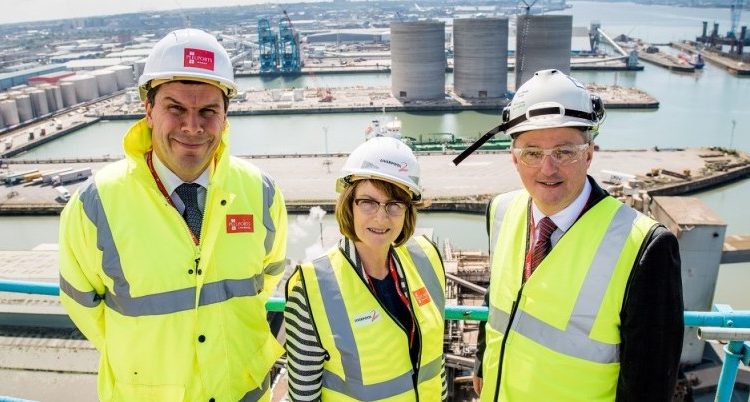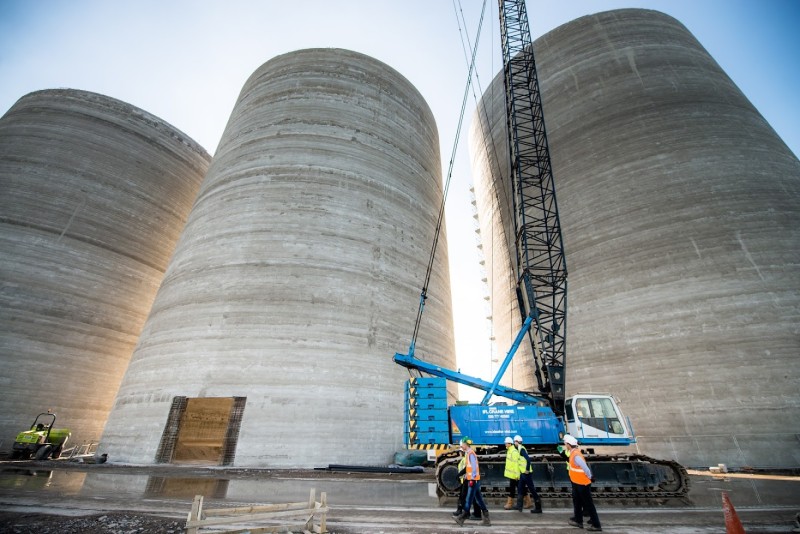Work is nearing completion on the first phase of the new £100m biomass terminal at the Port of Liverpool, which will eventually handle three million tonnes of wood pellets a year as part of the decarbonisation of Drax Power Station.
Liverpool Riverside MP, Louise Ellman visited the site on Friday, (August 7) to inspect the project, which will connect one of the busiest ports in the north to the UK’s single largest generator of renewable power.
The first phase of the new terminal, which will create 47 permanent jobs at the Port of Liverpool, will open in October when four trains a day begin carrying wood pellets to Drax.
Mrs Ellman, chair of the House of Commons Transport Select Committee, met with senior representatives from Peel Ports and Drax Group, to find out more about the project which proves the importance of east west connectivity across the north of England.
The wood pellets – to be shipped to Liverpool from North America – are a by-product of the commercial forestry and saw-milling industry and will provide the Selby-based power station with a sustainable and affordable low carbon fuel source.
Drax’s gradual conversion to biomass, which generates carbon savings of around 86% compared to coal, is a key part of the UK’s efforts to meet its 2020 renewable targets whilst keeping energy costs down for businesses and consumers. The power station is the largest decarbonisation project in Europe and accounted for 12.3% of the UK’s renewable power last year.
All of the wood pellets arriving at the Port of Liverpool will be sent to Drax by rail, ensuring there is no impact on the local road network. Up to 10 train loads of pellets will travel to the power station every day in custom-made biomass rail wagons once the terminal is fully completed in 2016.
The new biomass terminal is an important part of Peel Ports’ strategy around the transfer of freight from road to more sustainable rail and water solutions. The terminal will contribute to the ambitious growth plans for the Port of Liverpool, with the Company already investing £300m to create the UK’s most centrally located deep water container terminal, known as Liverpool2 and which is due to open in December 2015.
Liverpool2 will enable the port to handle the largest container ships in the global fleet while at the same time doubling the port’s container capacity.
During the visit, Mrs Ellman emphasised the important role rail freight plays in powering economic growth in the north of England. She also discussed the employment opportunities associated with the project.
Louise Ellman MP said:
“This project must be supported as part of The Northern Powerhouse. It will bring great benefits to Liverpool, including innovation, jobs and new trade opportunities. It is also a fantastic demonstration of the type of investment that will drive economic growth in the region through new port infrastructure, greater connectivity between east and west and new partnerships between great northern assets like the Port of Liverpool and Drax Power Station.”
Drax Head of Supply Chain & Logistics, Graham Backhouse said:
“This new Liverpool terminal will add to the facilities on the east coast of England, bolstering our supply chain still further. A robust supply chain is crucial to our operation as we continue the transition from coal to sustainable biomass providing the UK with reliable and affordable energy.”
Warren Marshall, Group Planning Director, Peel Ports, said:
“It was a pleasure to be able to show Louise around and talk her through the project as it nears completion. Not only are we opening Liverpool up to new trade opportunities but we are creating greater links across the North and unlocking the economic potential of The Northern Powerhouse.”
The announcement of the new terminal in June came shortly after Drax announced that it had saved its 20 millionth metric tonne of carbon since it started burning biomass. The company expects to reach the 50 millionth metric tonne mark in an additional two and a half years and the new terminal at Liverpool is now an important part of that journey.


